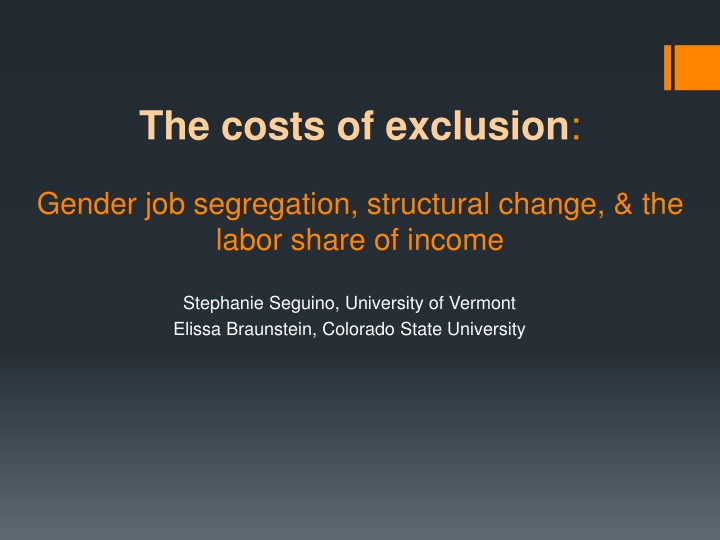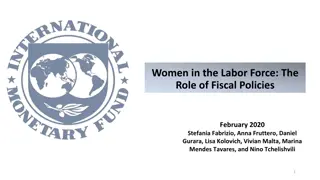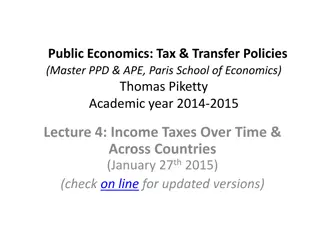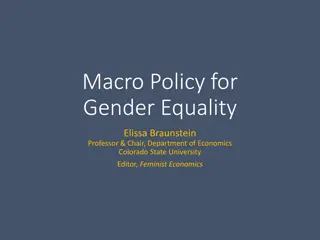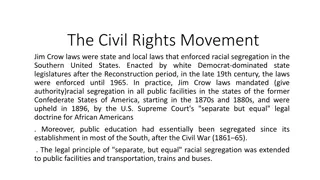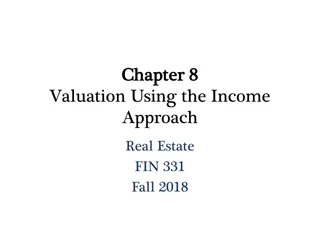Gender Job Segregation and Its Impact on Labor Share of Income
The paper discusses the concerning trend of gender job segregation and its implications on the labor share of income. It highlights three key global gender trends, emphasizing the persistence of employment gaps between men and women. The analysis raises questions about the macro-structural causes of increased job segregation and explores whether this trend affects both men and women by depressing the labor share of income. The study also examines the quality of industrial sector jobs compared to those in services and agriculture, shedding light on the importance of addressing gender disparities in employment.
Download Presentation

Please find below an Image/Link to download the presentation.
The content on the website is provided AS IS for your information and personal use only. It may not be sold, licensed, or shared on other websites without obtaining consent from the author.If you encounter any issues during the download, it is possible that the publisher has removed the file from their server.
You are allowed to download the files provided on this website for personal or commercial use, subject to the condition that they are used lawfully. All files are the property of their respective owners.
The content on the website is provided AS IS for your information and personal use only. It may not be sold, licensed, or shared on other websites without obtaining consent from the author.
E N D
Presentation Transcript
The costs of exclusion: Gender job segregation, structural change, & the labor share of income Stephanie Seguino, University of Vermont Elissa Braunstein, Colorado State University
3 key global gender trends Educational gender gaps substantially narrowed Far less improvement in gender employment gap but progress Gender job segregation has worsened. It is this puzzle we seek to explain in our paper.
But closure of employment gaps lagging: F/M Employment-to-Population Rates, 15+
Gender conflictive employment gains: F/M employment ratio rising as male employment rates fall Change in women's/men's employment rate 30 20 10 0 -10 -20 -10 0 10 20 Change in men's employment rate Developed countries Transition economies Developing countries
And job segregation is increasing: Women s relative concentration in industrial sector employment, developing countries, 1991 & 2010
Womens relative concentration in industrial sector employment, 1991 & 2010 20 14.4 13.1 11 10 5.3 4.7 4.1 2.8 0 -10 -14.8 -20 -21.8 -23 -30 -40 -42.8 -43.9 -50 Women's rel. concentration industrial jobs F/M employment rate ratio
Two questions 1. What are macro-structural causes of greater job segregation? 2. Does increased gender job segregation hurt men as well as women by depressing the labor share of income?
Good jobs in the industrial sector Are in fact industrial sector jobs of higher quality than those in services & agriculture? Industry relative to agriculture & services Jobs more likely to be formal, higher wage, less vulnerable work Ratio of market services sector to industrial sector productivity averages 85% across regions.
Macro-structural trends at work Structural change (premature deindustrialization, rising K/L, growing shortage of good jobs) Income nequality has dampened demand/limited job growth Rising F/M LFPR Result: intensified job competition shaped by gender stratification
Under conditions of job scarcity & thus rationing Access to good jobs influenced by processes of stratification in particular hoarding (exclusion). Results in dual labor market process of women s exclusion from good jobs & crowding into lower quality jobs.
Trends in industrial employment as a share of total employment, 1991- 2014 35 30 percent 25 20 15 1990 1995 2000 2005 2010 2015 year Developed countries Transition countries Developing countries
Econometric Analysis: Determinants of women s relative share of industrial sector jobs 4 sets of factors 1. Structural transformation & technological change 2. Structural & policy consequences of globalization 3. Overall growth 4. Labor Supply changes (panel data, 1990 to 2013)
Assessing gender-based exclusion in the context of structural change, globalization and growth in developing countries, 1991-2014 Factor Impact on women s relative access to good jobs Structural transformation and the gender inclusivity of technological change Industrial employment as a share of total employment Positive: Industrial value added matters a lot less Negative: Given gender stereotypes and segregation, technological change may hurt women s access to better jobs Higher capital intensity of production Structural and policy consequences of globalization Stronger fiscal policy stances Positive: Austerity detracts from gender equality Net (not total) exports of manufactures Positive: Domestic value added in exports matter, FDI doesn t Tariffs Positive: Less trade liberalization enhances women s access Economic growth No effect: Failure of growth to produce sufficient employment also a failure for gender equality Per capita GDP growth Women s involvement in markets Negative: Given the limited supply of good jobs, associated with increased gender segregation and crowding into bad jobs Increasing women s labor force participation
Are men also hurt by gender job segregation? Our main arguments are Core sector (male) jobs increasingly rationed Poor working conditions of peripheral sector (women s jobs) communicate cost of job loss if men lose privileged positions in core jobs Weakens fallback positions & bargaining power in the industrial sector, depressing wages & making it difficult to capture benefits of productivity growth. Greater job segregation decline in L share of income.
Results: Statistically significant variables only Dependent variable: L share of income Fixed effects 2SLS Women s rel. concentration in industrial sector jobs Women s rel. concentration 0.08 0.14 F/M LFPR Industrial VA/GDP Ind. emp/Total emp Ind. value added/GDP -0.18 -0.26 Inward FDI/GDP G. cons/GDP 0.04 0.04 Weighted tariffs Real i rates K/L ratio 0.16 0.16 G cons./GDP Trade/GDP Weighted tariffs *Women s share of industrial sector jobs may be endogenous, hence 2SLS. Instruments are lagged values of women s industrial concentration and net mfg. exports/GDP.
Implications of results Crowding hurts men s access to employment effect is large. Decline in F/M ind. employment 3.8 percentage point decline of L share from 1991-2010. Labor share fell 4.0 percentage points over that period. Falling L share cannot be attributed to increased F/M LFPR that squeezes men out of jobs Expansionary fiscal policies & less trade liberalization raise labor shares.
Conclusions Due to declining no. of good jobs, women's increased employment has led to their integration on inferior terms. This worsens overall inequality by lowering the labor share of income with negative effects for aggregate demand & growth. What progress we have seen in increased relative female employment is thus gender conflictive.
